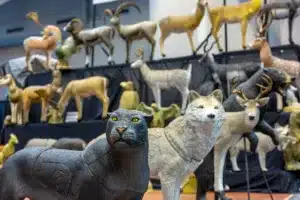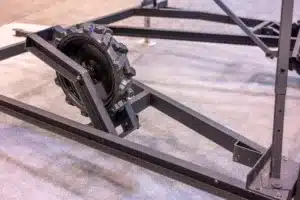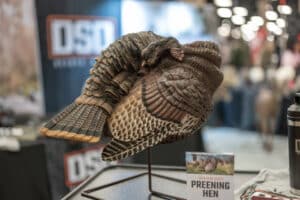No products in the cart.

365 Archery 3D Archery Targets
When folks enter a new industry, or even a new subsection of their industry, they usually dip their toe in by offering one or two

THE STALK:

Now that you have put your buck to bed, it’s time to decide on a strategy. Big bucks like to bed where they can see danger far before its ever a threat. Laying down with their backside well protected, they scan the area in front of them for danger. When planning your approach keep this in mind, they are expecting predators to appear from below and in front of them not from behind and above. There are some things that must be done before heading out on the stalk however.

First, establish landmarks and their relation to the bedded animal. It’s not fun to blow out the buck of a lifetime because you didn’t know exactly where he was. Second, figure wind direction and speed. You obviously want to have the wind in your face at all times when closing the distance and wind speed doubles as a noise buffer. Thirdly, I like to range different landmarks from the animal to get an idea of how close I can get or how far the shot will be. If I range the deer at 500 yards and a yucca plant just beyond him at 550 yards, I now know that it’s a 50 yard shot from the yucca plant to the deer. Use the lay of the land to your advantage and keep out of sight, only peaking up occasionally to locate and confirm the animal has not moved or been alerted. Scan for other animals that may also be around the animal you are after or on your approach route, as they can give away your location and blow the stalk.
These stalking situations require a lot of movement and your clothing choices can play a huge role in the outcome. Limit your stalking wardrobe to earth tones and camouflage that goes well with your surroundings. I observed a couple of hunters last year over a mile away, one had blue jeans on and the other a brown pair of pants. The blue jeans stood out like a sore thumb while the brown pants were tougher to see, even while moving. Those far distances may not get animals up from their beds, but it will make them on edge more than before and may cause a stalk to be blown before it ever really starts.

The main body parts I dedicate to camouflage on every hunt are my torso, face and hands. I think that these are the parts that move the most during the final stages of a stalk when concealment is critical. Putting a light weight pair of gloves on your hands will not only help in keeping you concealed during the draw cycle and other movements, but will also double to keep your hands from getting stickers in them during the stalk. I will cover my face to not only break up the symmetry but also to prevent glare from the sun. I prefer face paint over a face mask but I do have both with me on every hunt. Sitka Gear has an outstanding line of clothing specifically designed for the spot and stalk type hunter in open terrain.
The last 100 yards of the stalk are when things get critical. Usually by this time you will have confirmed the animal is still bedded for the last time, and will not lay eyes on him again until moments before the shot. The wind speed plays a crucial role at this stage, and could be the final factor as to if the distance needed for a comfortable shot can be met without detection. A light inconsistent breeze may cause your scent to swirl and reach the animal even though it may be in your favor.

Watch where you are stepping. Try to keep boots on the dirt and not crunching on dead grass, taking your boots off into your socks may even be appropriate for low noise. Work stealthy and most of all, have patience. If the animal doesn’t know you are there he won’t be in any hurry to get up or leave, so don’t be in a big rush to get there or rush a shot. Rushing will cause you to get sloppy and make unnecessary movements and noise, most likely causing an educated buck to leave the country. Try to stick in the shadows and out of the sunlight if possible. I like to range a few things around me every ten steps or so to keep them updated and fresh in my mind if I had to make a quick unexpected shot. If you think you’ve reached the point where he should be but don’t see him, don’t give up too quickly and stand up thinking he’s gone. Most likely he just got up to feed or move, in which case he won’t be far off. Use your optics to pick apart the scene and look for parts of the animal. Ears, antler tips, tail flickers are all things that will jump out at you. Another advantage to this is slowing you down and keeping focused on the task at hand. Just move with extra caution and keep your eyes peeled for a shot opportunity. In the event you are busted, sit tight in cover and watch what they do. More than likely they don’t know what they heard or saw so they may be uneasy for a while but will eventually calm down and not move too far off. Reassess the situation and start the stalk over again.
When the distance has been closed with no detection, take a breath and get comfortable. By this time your heart rate should be up and anticipation has kicked in. Catch your breath, get calmed down, and think about how to execute the shot. You may have to make him stand up. The best way of doing so is with something natural that won’t make him blow out of his bed, stopping just outside of shooting range. By far the best is to wait him out. By letting him stand up himself your avoiding an edginess that may make him “jump the string” causing a poor placed shot or a complete miss and missed opportunity. If he is bedded where his vitals are free of obstructions your best option may be to make the shot while still in his bed. However there are times when you need them to stand up and present a shot, such as if you’re loosing shooting light.

When your shot opportunity arises, as your coming to full draw or clicking your safety off, muscle memory takes over and every day spent shooting and practicing all pays off in one moment.
SCENARIOS:
While having a buck bedded down all by himself in a totally approachable spot is ideal, it’s not the reality most of the time. I don’t think I have been on a single stalk where everything worked out textbook with no unplanned factors interfering. I was recently on the stalk of a mule deer buck bedded on the side of a hill, along with eight other bucks. I knew I was not going to get into range of the shooter because of where the other bucks were positioned, but I wanted to get as close as I could so a move could be made quickly if presented. While within 200 yards of the deer I encountered a small buck antelope bedded in my planned route. With only a small hill between me and the deer I couldn’t defer my route to the left or right enough to avoid the goat spotting me. Deciding that if I were to come to him at an angle he would run the opposite direction of the deer and not be an issue, I set off on the final leg of the approach. To my surprise, I walked by within 90 yards of him while he stood motionless, only to run back past me and right into the bedded deer. Thinking the stalk was blown I hunched down and sat still, listening to the deer snorting my direction. After about 15 minutes of no movement I crawled up the hill, peeked over, and to my surprise all of the deer were still right where I had left them. With the wind in my favor and none of them sighting or hearing me, they had settled back down and the stalk proceeded as planned. Although I never got a shot that evening, I learned that patience and persistence won me another chance at possibly getting a shot. If I would have stormed off over the hill thinking the deer were long gone they would have definitely seen what I was and left the county.
Last year I learned you don’t need to be out of sight by the whole deer, only his eyes. I had located a great whitetail buck bedded along a fence the second morning of season. I had planned to keep an eye on him and wait until he moved to a more approachable spot, as it was he was in the wide open being able to see miles around him. He was very close to a well-traveled road and my worry was he would take off from his bed and move onto the neighboring ground, so I headed out to attempt an approach from his backside. He happened to be bedded right in front of a fence post and from the distance I was at, his whole head was covered so I decided to walk straight towards him keeping the post between him and I.

As I passed the 100 yard mark I couldn’t believe he had yet to turn his head and look my way or even act suspicious, but as the yards shrank the post did too. Luckily he was laying in a way that he couldn’t turn his head enough to get both eyes on me, so I only had one eye to keep behind the post. Within 70 yards he knew something wasn’t right but I was in his blind spot with the wind in my favor, he had almost no reason to feel directly threatened. As I hit 50 yards, with only a slight breeze I knew I was really pushing it trying to get closer, so decided to take the next shot that presented itself. Thinking a vehicle could come down the road at any second I drew my bow, made a couple grunting noises to get him up, and made the shot. Now that mature deer is on my wall only because of one fence post and a ton of patience. Use whatever cover is available and focus on keeping his eyes covered, you may be able to walk straight to him.
We hope this information answered some questions and added some tactics to your arsenal. Don’t hesitate to contact us with any further questions to help make your next SELFILMED hunt a success!
Stay up to date with our blog by subscribing via e-mail, in the top right hand corner of this page. Then, head over to our Facebook page at facebook.com/SELFILMED and give us a like for the latest updates, pictures, videos, and giveaways!
For more information on Sitka Gear, visit their website at www.sitkagear.com for their latest lines of outstanding clothing and gear to serve you in big game and waterfowl hunting.

When folks enter a new industry, or even a new subsection of their industry, they usually dip their toe in by offering one or two

Highlights of Greylight’s new releases for 2024 – the Daybreak Blind, Transformer Tower, and Nomad trailer.

With one of their coolest decoys to date, the NWTF floor was buzzing with talk of the new DSD Preening Hen decoy. It’s almost TOO
Don’t miss a thing! Subscribe below to keep informed on everything that’s happening with the folks at SELFILMED.com